Business Process Modeling (BPMN) for Textbook Resale at University
VerifiedAdded on 2021/06/17
|9
|1910
|223
Report
AI Summary
This report presents a Business Process Modeling (BPMN) analysis for a company contracted by a university to buy and resell used textbooks. The model outlines a digitalized process involving four key levels: the Company, Processing of an Order, Shipping via DHL, and the University. The process begins with the company soliciting former students to sell their books and culminates in the university distributing the books to buyers, with the company paying the university a concession fee. The report details each stage, including order placement, book evaluation, payment processing via PayPal, and shipment tracking. The BPMN also identifies five potential end points in the sales process, such as book rejection or credit card validation failures, and highlights the benefits of the model for stakeholders, including improved operational efficiency and enhanced communication. The report concludes with a visual representation of the business process model, designed to facilitate efficient textbook resale within the university context.
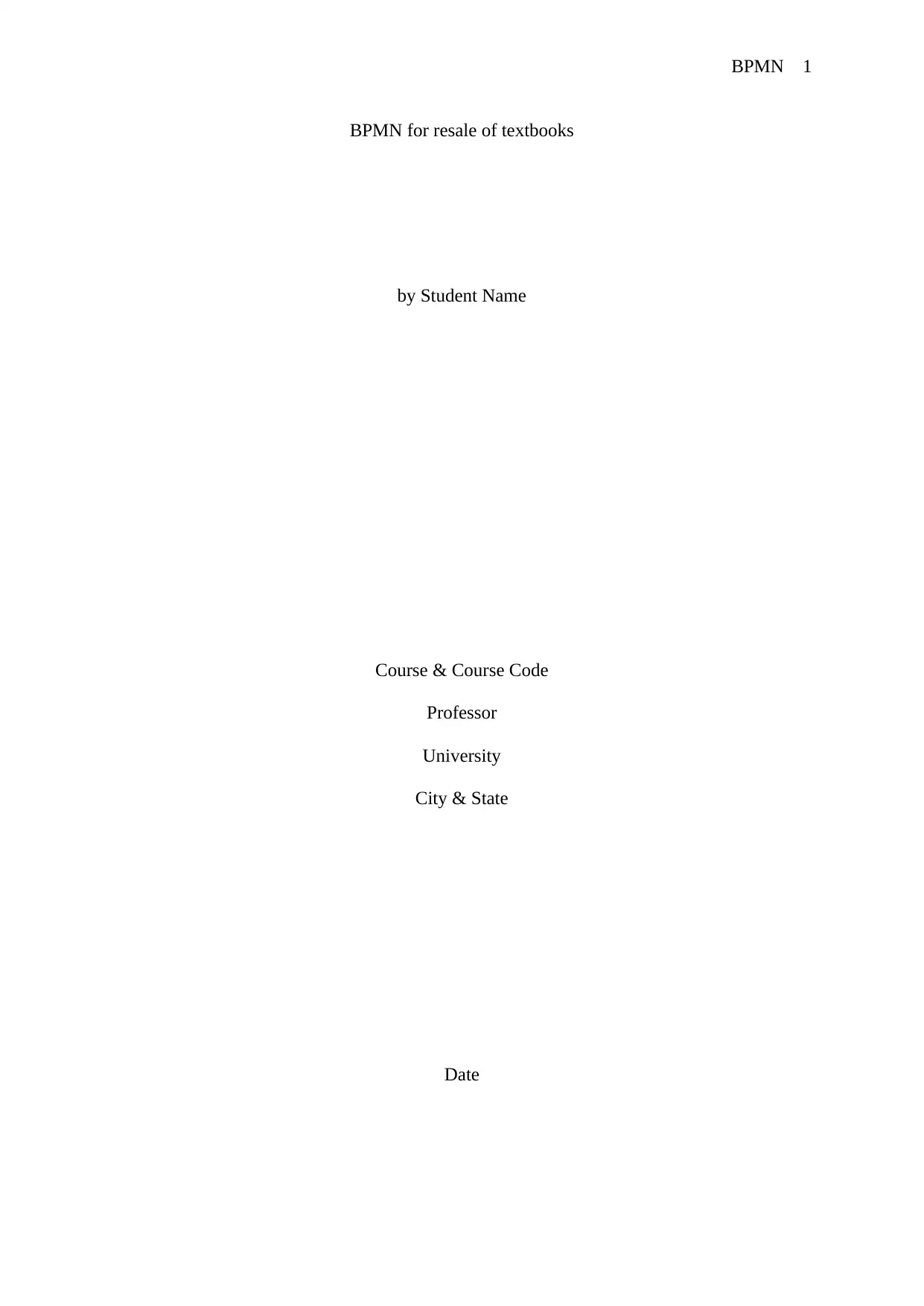
BPMN 1
BPMN for resale of textbooks
by Student Name
Course & Course Code
Professor
University
City & State
Date
BPMN for resale of textbooks
by Student Name
Course & Course Code
Professor
University
City & State
Date
Paraphrase This Document
Need a fresh take? Get an instant paraphrase of this document with our AI Paraphraser
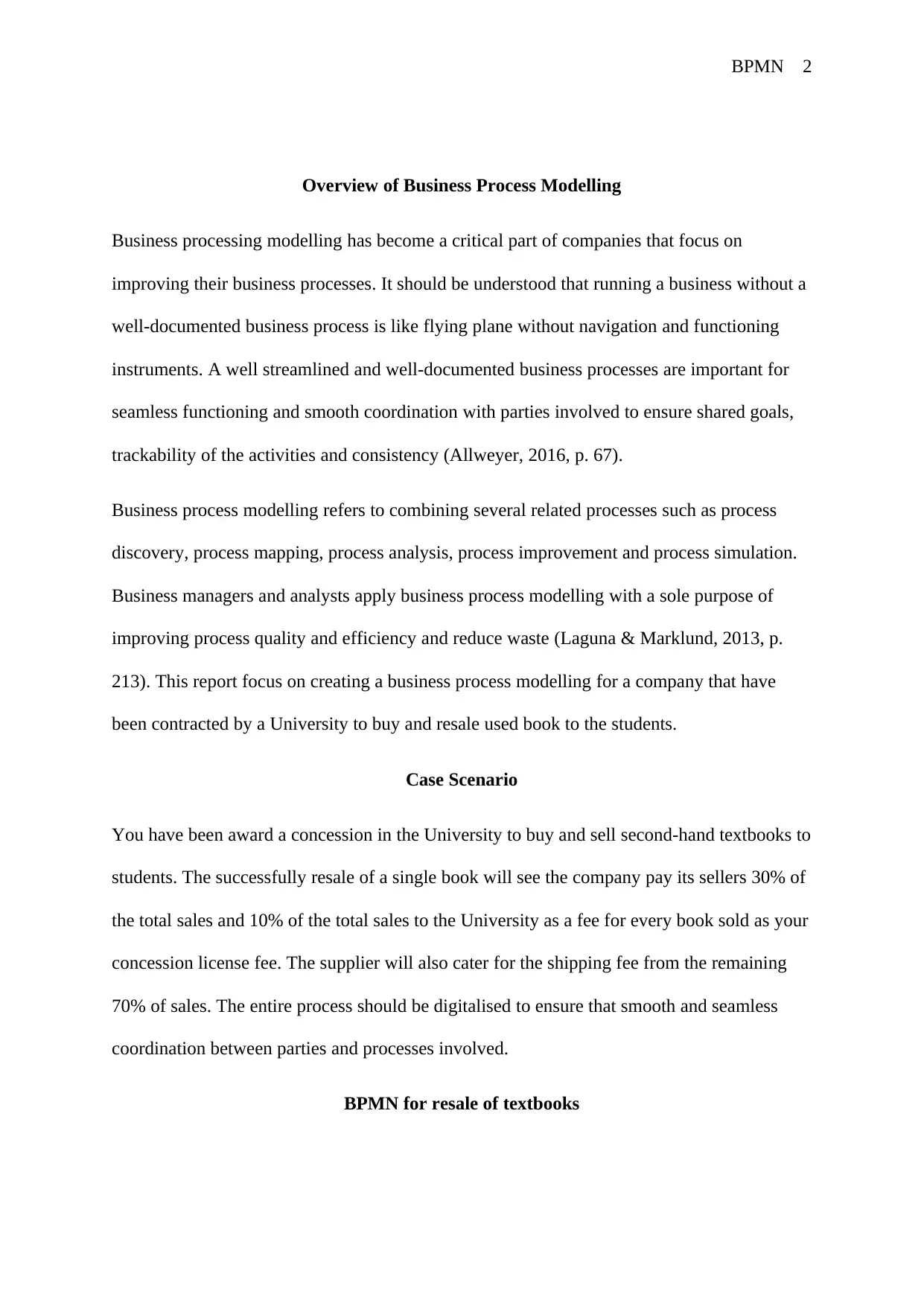
BPMN 2
Overview of Business Process Modelling
Business processing modelling has become a critical part of companies that focus on
improving their business processes. It should be understood that running a business without a
well-documented business process is like flying plane without navigation and functioning
instruments. A well streamlined and well-documented business processes are important for
seamless functioning and smooth coordination with parties involved to ensure shared goals,
trackability of the activities and consistency (Allweyer, 2016, p. 67).
Business process modelling refers to combining several related processes such as process
discovery, process mapping, process analysis, process improvement and process simulation.
Business managers and analysts apply business process modelling with a sole purpose of
improving process quality and efficiency and reduce waste (Laguna & Marklund, 2013, p.
213). This report focus on creating a business process modelling for a company that have
been contracted by a University to buy and resale used book to the students.
Case Scenario
You have been award a concession in the University to buy and sell second-hand textbooks to
students. The successfully resale of a single book will see the company pay its sellers 30% of
the total sales and 10% of the total sales to the University as a fee for every book sold as your
concession license fee. The supplier will also cater for the shipping fee from the remaining
70% of sales. The entire process should be digitalised to ensure that smooth and seamless
coordination between parties and processes involved.
BPMN for resale of textbooks
Overview of Business Process Modelling
Business processing modelling has become a critical part of companies that focus on
improving their business processes. It should be understood that running a business without a
well-documented business process is like flying plane without navigation and functioning
instruments. A well streamlined and well-documented business processes are important for
seamless functioning and smooth coordination with parties involved to ensure shared goals,
trackability of the activities and consistency (Allweyer, 2016, p. 67).
Business process modelling refers to combining several related processes such as process
discovery, process mapping, process analysis, process improvement and process simulation.
Business managers and analysts apply business process modelling with a sole purpose of
improving process quality and efficiency and reduce waste (Laguna & Marklund, 2013, p.
213). This report focus on creating a business process modelling for a company that have
been contracted by a University to buy and resale used book to the students.
Case Scenario
You have been award a concession in the University to buy and sell second-hand textbooks to
students. The successfully resale of a single book will see the company pay its sellers 30% of
the total sales and 10% of the total sales to the University as a fee for every book sold as your
concession license fee. The supplier will also cater for the shipping fee from the remaining
70% of sales. The entire process should be digitalised to ensure that smooth and seamless
coordination between parties and processes involved.
BPMN for resale of textbooks
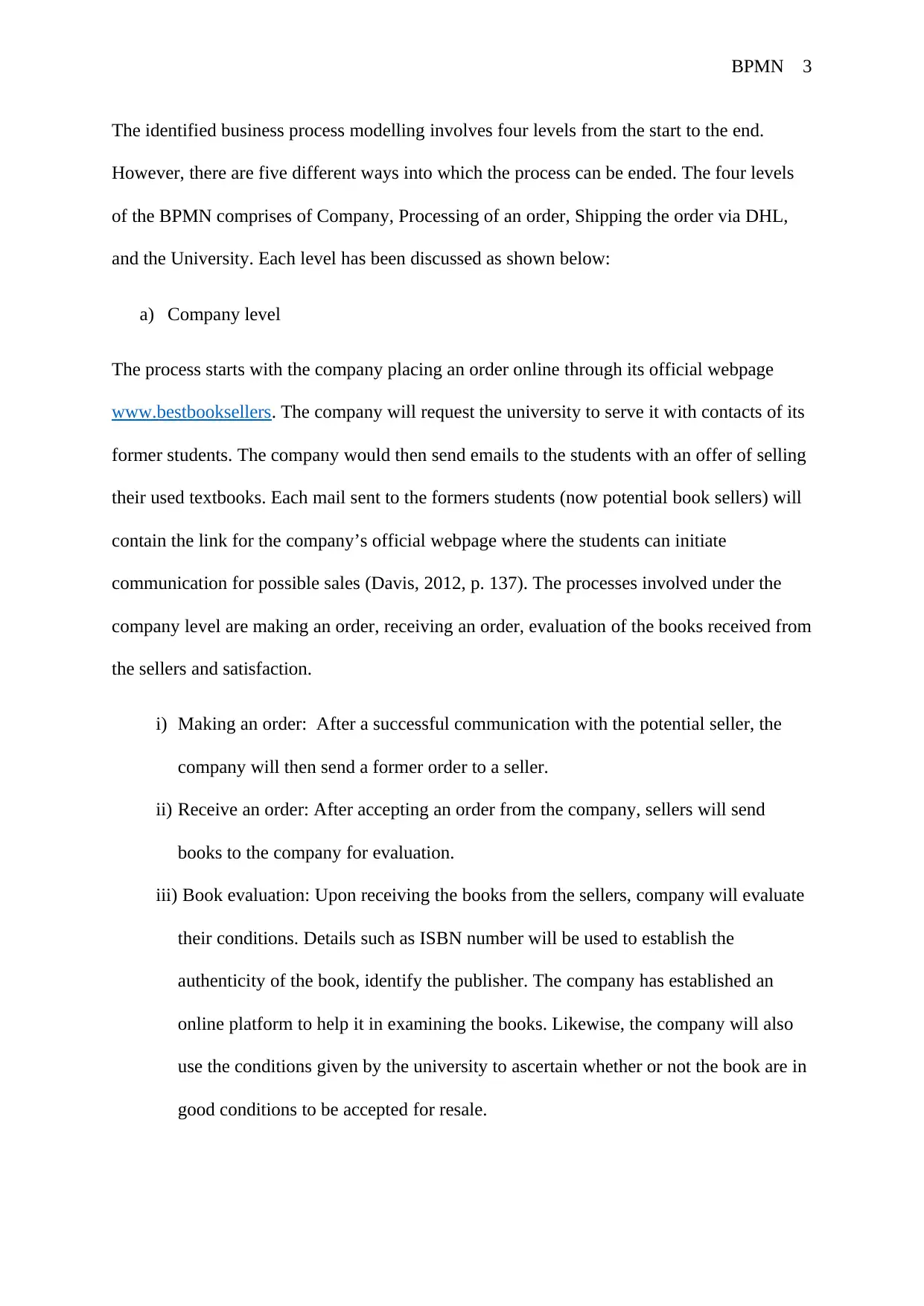
BPMN 3
The identified business process modelling involves four levels from the start to the end.
However, there are five different ways into which the process can be ended. The four levels
of the BPMN comprises of Company, Processing of an order, Shipping the order via DHL,
and the University. Each level has been discussed as shown below:
a) Company level
The process starts with the company placing an order online through its official webpage
www.bestbooksellers. The company will request the university to serve it with contacts of its
former students. The company would then send emails to the students with an offer of selling
their used textbooks. Each mail sent to the formers students (now potential book sellers) will
contain the link for the company’s official webpage where the students can initiate
communication for possible sales (Davis, 2012, p. 137). The processes involved under the
company level are making an order, receiving an order, evaluation of the books received from
the sellers and satisfaction.
i) Making an order: After a successful communication with the potential seller, the
company will then send a former order to a seller.
ii) Receive an order: After accepting an order from the company, sellers will send
books to the company for evaluation.
iii) Book evaluation: Upon receiving the books from the sellers, company will evaluate
their conditions. Details such as ISBN number will be used to establish the
authenticity of the book, identify the publisher. The company has established an
online platform to help it in examining the books. Likewise, the company will also
use the conditions given by the university to ascertain whether or not the book are in
good conditions to be accepted for resale.
The identified business process modelling involves four levels from the start to the end.
However, there are five different ways into which the process can be ended. The four levels
of the BPMN comprises of Company, Processing of an order, Shipping the order via DHL,
and the University. Each level has been discussed as shown below:
a) Company level
The process starts with the company placing an order online through its official webpage
www.bestbooksellers. The company will request the university to serve it with contacts of its
former students. The company would then send emails to the students with an offer of selling
their used textbooks. Each mail sent to the formers students (now potential book sellers) will
contain the link for the company’s official webpage where the students can initiate
communication for possible sales (Davis, 2012, p. 137). The processes involved under the
company level are making an order, receiving an order, evaluation of the books received from
the sellers and satisfaction.
i) Making an order: After a successful communication with the potential seller, the
company will then send a former order to a seller.
ii) Receive an order: After accepting an order from the company, sellers will send
books to the company for evaluation.
iii) Book evaluation: Upon receiving the books from the sellers, company will evaluate
their conditions. Details such as ISBN number will be used to establish the
authenticity of the book, identify the publisher. The company has established an
online platform to help it in examining the books. Likewise, the company will also
use the conditions given by the university to ascertain whether or not the book are in
good conditions to be accepted for resale.
⊘ This is a preview!⊘
Do you want full access?
Subscribe today to unlock all pages.

Trusted by 1+ million students worldwide
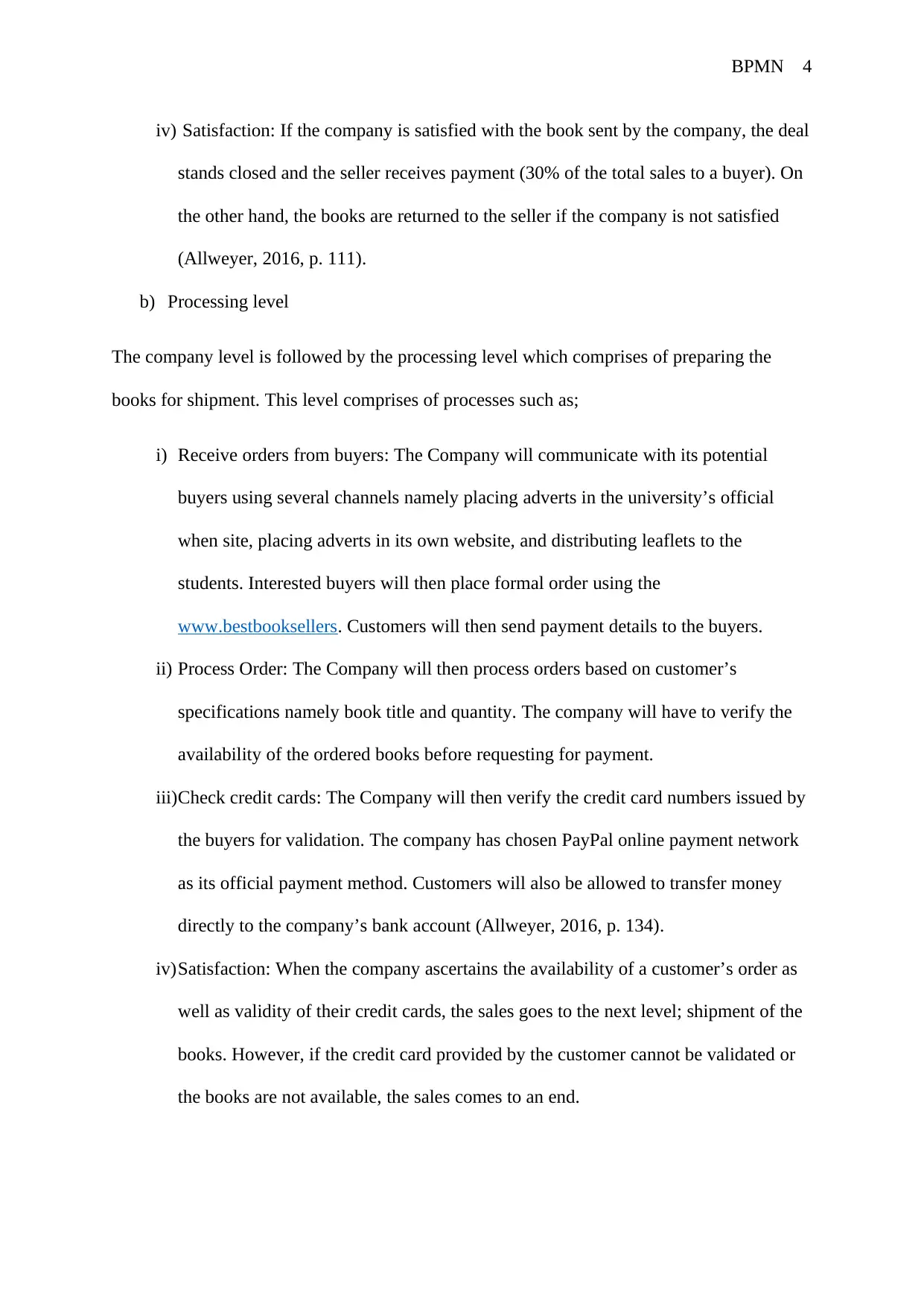
BPMN 4
iv) Satisfaction: If the company is satisfied with the book sent by the company, the deal
stands closed and the seller receives payment (30% of the total sales to a buyer). On
the other hand, the books are returned to the seller if the company is not satisfied
(Allweyer, 2016, p. 111).
b) Processing level
The company level is followed by the processing level which comprises of preparing the
books for shipment. This level comprises of processes such as;
i) Receive orders from buyers: The Company will communicate with its potential
buyers using several channels namely placing adverts in the university’s official
when site, placing adverts in its own website, and distributing leaflets to the
students. Interested buyers will then place formal order using the
www.bestbooksellers. Customers will then send payment details to the buyers.
ii) Process Order: The Company will then process orders based on customer’s
specifications namely book title and quantity. The company will have to verify the
availability of the ordered books before requesting for payment.
iii)Check credit cards: The Company will then verify the credit card numbers issued by
the buyers for validation. The company has chosen PayPal online payment network
as its official payment method. Customers will also be allowed to transfer money
directly to the company’s bank account (Allweyer, 2016, p. 134).
iv)Satisfaction: When the company ascertains the availability of a customer’s order as
well as validity of their credit cards, the sales goes to the next level; shipment of the
books. However, if the credit card provided by the customer cannot be validated or
the books are not available, the sales comes to an end.
iv) Satisfaction: If the company is satisfied with the book sent by the company, the deal
stands closed and the seller receives payment (30% of the total sales to a buyer). On
the other hand, the books are returned to the seller if the company is not satisfied
(Allweyer, 2016, p. 111).
b) Processing level
The company level is followed by the processing level which comprises of preparing the
books for shipment. This level comprises of processes such as;
i) Receive orders from buyers: The Company will communicate with its potential
buyers using several channels namely placing adverts in the university’s official
when site, placing adverts in its own website, and distributing leaflets to the
students. Interested buyers will then place formal order using the
www.bestbooksellers. Customers will then send payment details to the buyers.
ii) Process Order: The Company will then process orders based on customer’s
specifications namely book title and quantity. The company will have to verify the
availability of the ordered books before requesting for payment.
iii)Check credit cards: The Company will then verify the credit card numbers issued by
the buyers for validation. The company has chosen PayPal online payment network
as its official payment method. Customers will also be allowed to transfer money
directly to the company’s bank account (Allweyer, 2016, p. 134).
iv)Satisfaction: When the company ascertains the availability of a customer’s order as
well as validity of their credit cards, the sales goes to the next level; shipment of the
books. However, if the credit card provided by the customer cannot be validated or
the books are not available, the sales comes to an end.
Paraphrase This Document
Need a fresh take? Get an instant paraphrase of this document with our AI Paraphraser
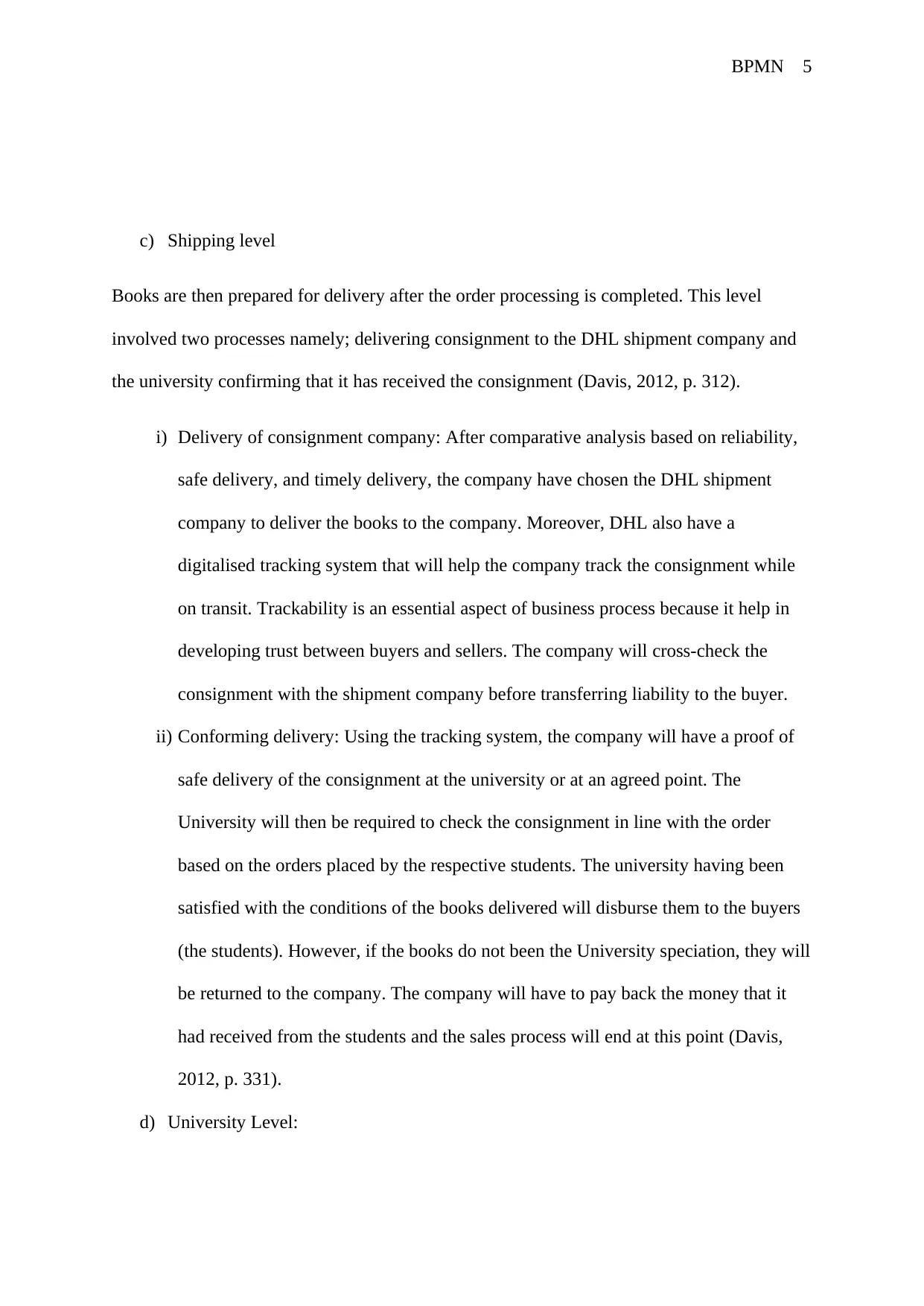
BPMN 5
c) Shipping level
Books are then prepared for delivery after the order processing is completed. This level
involved two processes namely; delivering consignment to the DHL shipment company and
the university confirming that it has received the consignment (Davis, 2012, p. 312).
i) Delivery of consignment company: After comparative analysis based on reliability,
safe delivery, and timely delivery, the company have chosen the DHL shipment
company to deliver the books to the company. Moreover, DHL also have a
digitalised tracking system that will help the company track the consignment while
on transit. Trackability is an essential aspect of business process because it help in
developing trust between buyers and sellers. The company will cross-check the
consignment with the shipment company before transferring liability to the buyer.
ii) Conforming delivery: Using the tracking system, the company will have a proof of
safe delivery of the consignment at the university or at an agreed point. The
University will then be required to check the consignment in line with the order
based on the orders placed by the respective students. The university having been
satisfied with the conditions of the books delivered will disburse them to the buyers
(the students). However, if the books do not been the University speciation, they will
be returned to the company. The company will have to pay back the money that it
had received from the students and the sales process will end at this point (Davis,
2012, p. 331).
d) University Level:
c) Shipping level
Books are then prepared for delivery after the order processing is completed. This level
involved two processes namely; delivering consignment to the DHL shipment company and
the university confirming that it has received the consignment (Davis, 2012, p. 312).
i) Delivery of consignment company: After comparative analysis based on reliability,
safe delivery, and timely delivery, the company have chosen the DHL shipment
company to deliver the books to the company. Moreover, DHL also have a
digitalised tracking system that will help the company track the consignment while
on transit. Trackability is an essential aspect of business process because it help in
developing trust between buyers and sellers. The company will cross-check the
consignment with the shipment company before transferring liability to the buyer.
ii) Conforming delivery: Using the tracking system, the company will have a proof of
safe delivery of the consignment at the university or at an agreed point. The
University will then be required to check the consignment in line with the order
based on the orders placed by the respective students. The university having been
satisfied with the conditions of the books delivered will disburse them to the buyers
(the students). However, if the books do not been the University speciation, they will
be returned to the company. The company will have to pay back the money that it
had received from the students and the sales process will end at this point (Davis,
2012, p. 331).
d) University Level:
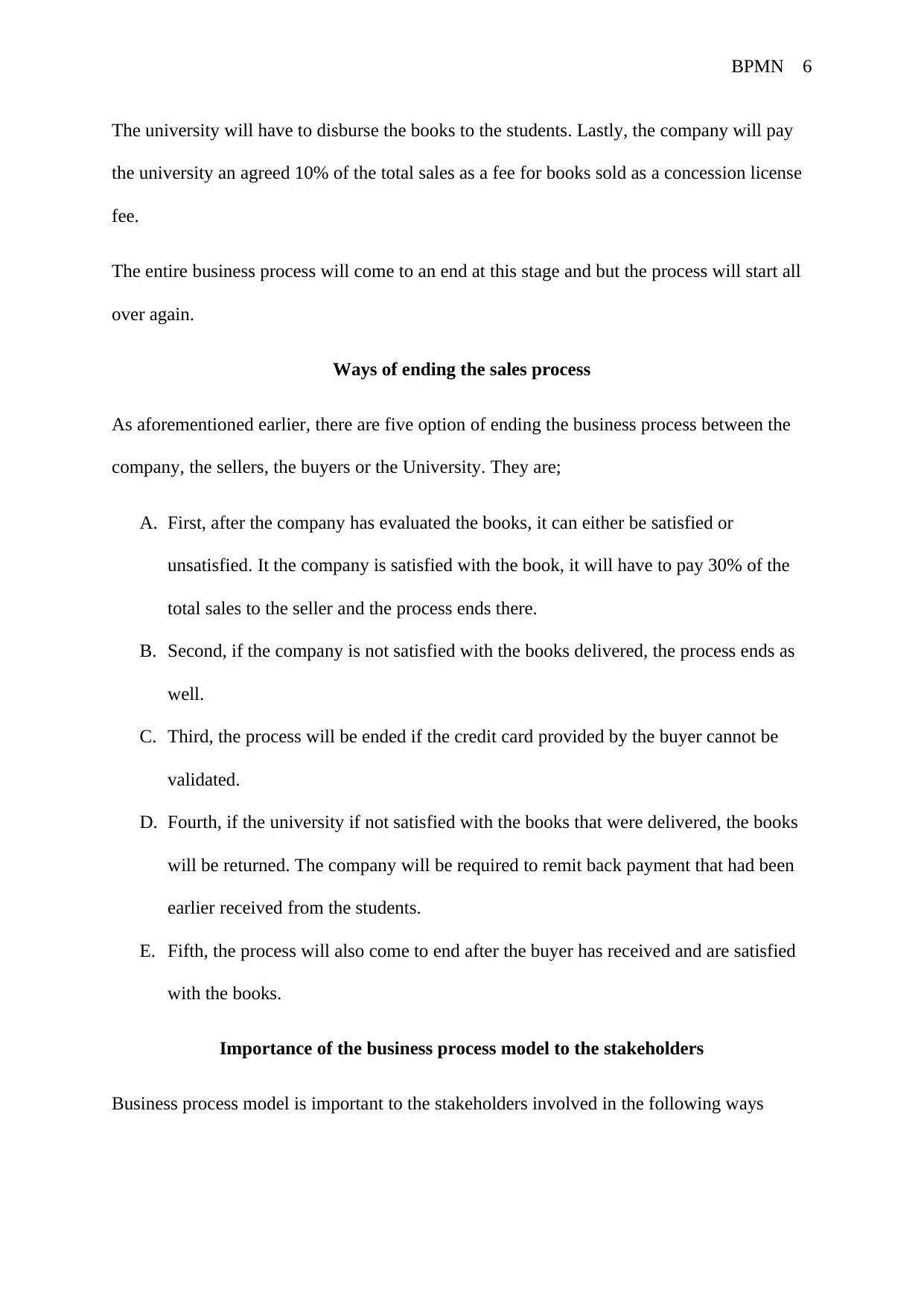
BPMN 6
The university will have to disburse the books to the students. Lastly, the company will pay
the university an agreed 10% of the total sales as a fee for books sold as a concession license
fee.
The entire business process will come to an end at this stage and but the process will start all
over again.
Ways of ending the sales process
As aforementioned earlier, there are five option of ending the business process between the
company, the sellers, the buyers or the University. They are;
A. First, after the company has evaluated the books, it can either be satisfied or
unsatisfied. It the company is satisfied with the book, it will have to pay 30% of the
total sales to the seller and the process ends there.
B. Second, if the company is not satisfied with the books delivered, the process ends as
well.
C. Third, the process will be ended if the credit card provided by the buyer cannot be
validated.
D. Fourth, if the university if not satisfied with the books that were delivered, the books
will be returned. The company will be required to remit back payment that had been
earlier received from the students.
E. Fifth, the process will also come to end after the buyer has received and are satisfied
with the books.
Importance of the business process model to the stakeholders
Business process model is important to the stakeholders involved in the following ways
The university will have to disburse the books to the students. Lastly, the company will pay
the university an agreed 10% of the total sales as a fee for books sold as a concession license
fee.
The entire business process will come to an end at this stage and but the process will start all
over again.
Ways of ending the sales process
As aforementioned earlier, there are five option of ending the business process between the
company, the sellers, the buyers or the University. They are;
A. First, after the company has evaluated the books, it can either be satisfied or
unsatisfied. It the company is satisfied with the book, it will have to pay 30% of the
total sales to the seller and the process ends there.
B. Second, if the company is not satisfied with the books delivered, the process ends as
well.
C. Third, the process will be ended if the credit card provided by the buyer cannot be
validated.
D. Fourth, if the university if not satisfied with the books that were delivered, the books
will be returned. The company will be required to remit back payment that had been
earlier received from the students.
E. Fifth, the process will also come to end after the buyer has received and are satisfied
with the books.
Importance of the business process model to the stakeholders
Business process model is important to the stakeholders involved in the following ways
⊘ This is a preview!⊘
Do you want full access?
Subscribe today to unlock all pages.

Trusted by 1+ million students worldwide
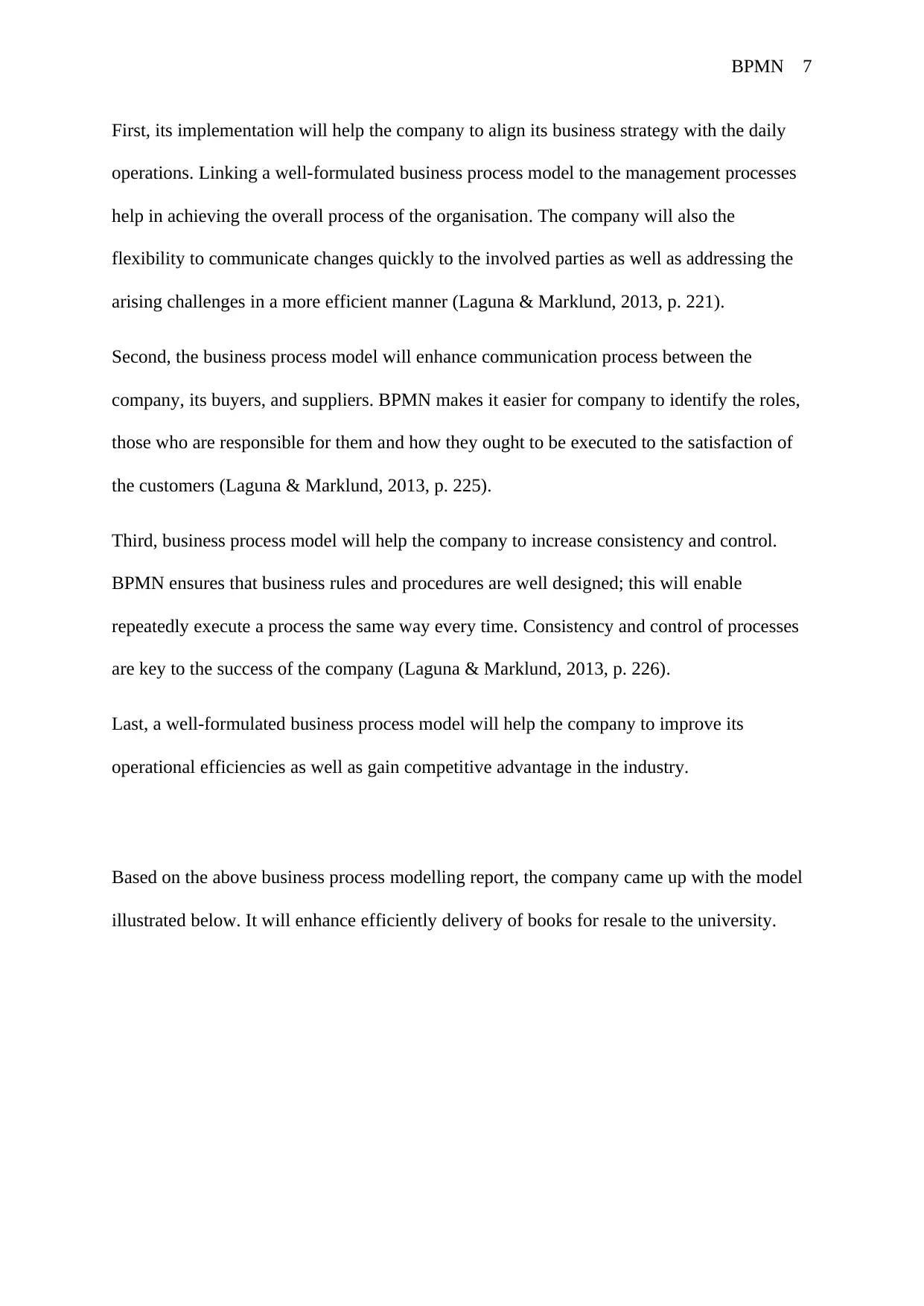
BPMN 7
First, its implementation will help the company to align its business strategy with the daily
operations. Linking a well-formulated business process model to the management processes
help in achieving the overall process of the organisation. The company will also the
flexibility to communicate changes quickly to the involved parties as well as addressing the
arising challenges in a more efficient manner (Laguna & Marklund, 2013, p. 221).
Second, the business process model will enhance communication process between the
company, its buyers, and suppliers. BPMN makes it easier for company to identify the roles,
those who are responsible for them and how they ought to be executed to the satisfaction of
the customers (Laguna & Marklund, 2013, p. 225).
Third, business process model will help the company to increase consistency and control.
BPMN ensures that business rules and procedures are well designed; this will enable
repeatedly execute a process the same way every time. Consistency and control of processes
are key to the success of the company (Laguna & Marklund, 2013, p. 226).
Last, a well-formulated business process model will help the company to improve its
operational efficiencies as well as gain competitive advantage in the industry.
Based on the above business process modelling report, the company came up with the model
illustrated below. It will enhance efficiently delivery of books for resale to the university.
First, its implementation will help the company to align its business strategy with the daily
operations. Linking a well-formulated business process model to the management processes
help in achieving the overall process of the organisation. The company will also the
flexibility to communicate changes quickly to the involved parties as well as addressing the
arising challenges in a more efficient manner (Laguna & Marklund, 2013, p. 221).
Second, the business process model will enhance communication process between the
company, its buyers, and suppliers. BPMN makes it easier for company to identify the roles,
those who are responsible for them and how they ought to be executed to the satisfaction of
the customers (Laguna & Marklund, 2013, p. 225).
Third, business process model will help the company to increase consistency and control.
BPMN ensures that business rules and procedures are well designed; this will enable
repeatedly execute a process the same way every time. Consistency and control of processes
are key to the success of the company (Laguna & Marklund, 2013, p. 226).
Last, a well-formulated business process model will help the company to improve its
operational efficiencies as well as gain competitive advantage in the industry.
Based on the above business process modelling report, the company came up with the model
illustrated below. It will enhance efficiently delivery of books for resale to the university.
Paraphrase This Document
Need a fresh take? Get an instant paraphrase of this document with our AI Paraphraser
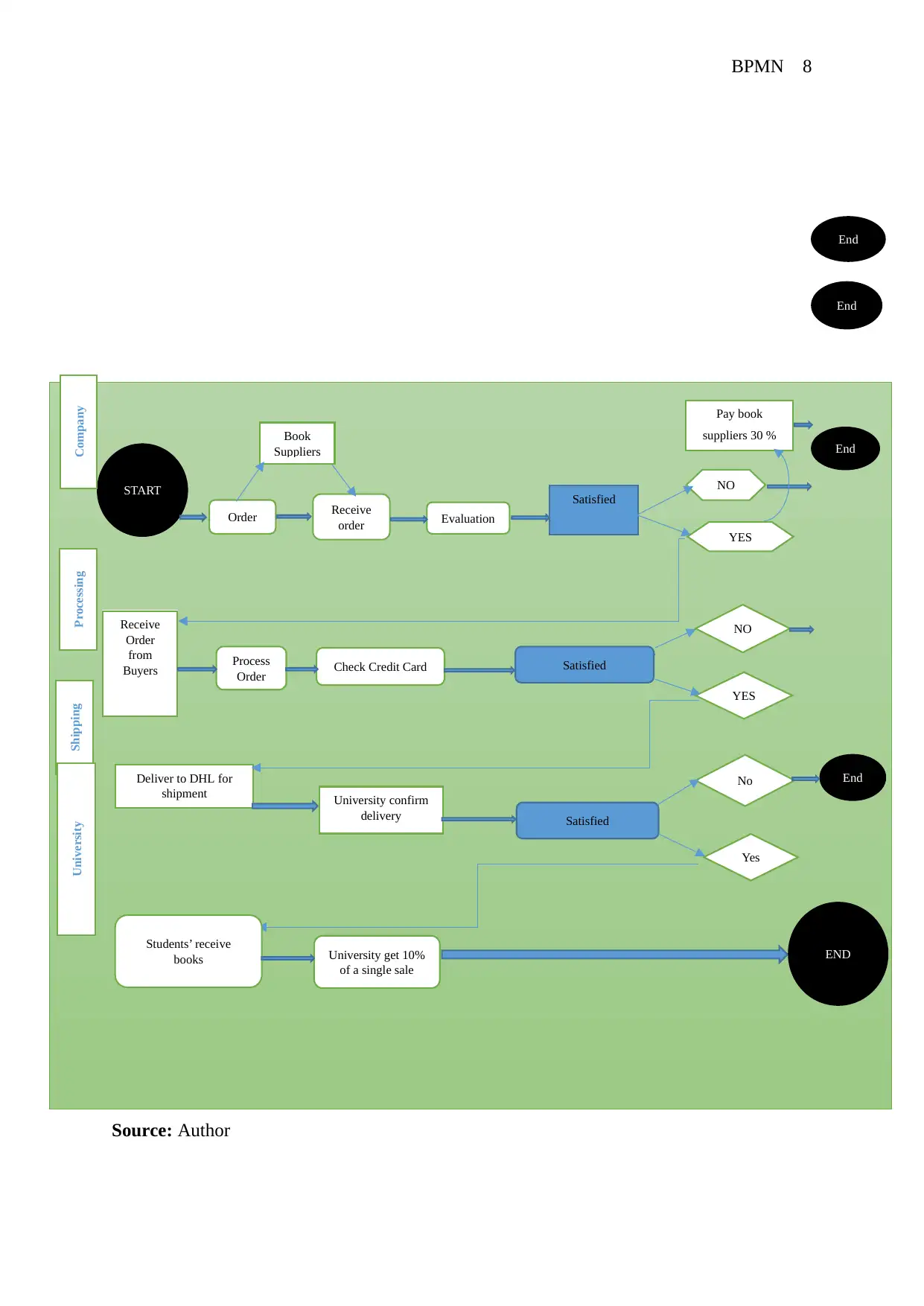
BPMN 8
Source: Author
START
Order
Book
Suppliers
Receive
order Evaluation
Satisfied
NO
YES
End
Company Pay book
suppliers 30 %
End
Processing
Receive
Order
from
Buyers Process
Order Check Credit Card Satisfied
NO
YES
End
Shipping
Deliver to DHL for
shipment University confirm
delivery Satisfied
No
Yes
End
University get 10%
of a single sale
University
END
Students’ receive
books
Source: Author
START
Order
Book
Suppliers
Receive
order Evaluation
Satisfied
NO
YES
End
Company Pay book
suppliers 30 %
End
Processing
Receive
Order
from
Buyers Process
Order Check Credit Card Satisfied
NO
YES
End
Shipping
Deliver to DHL for
shipment University confirm
delivery Satisfied
No
Yes
End
University get 10%
of a single sale
University
END
Students’ receive
books
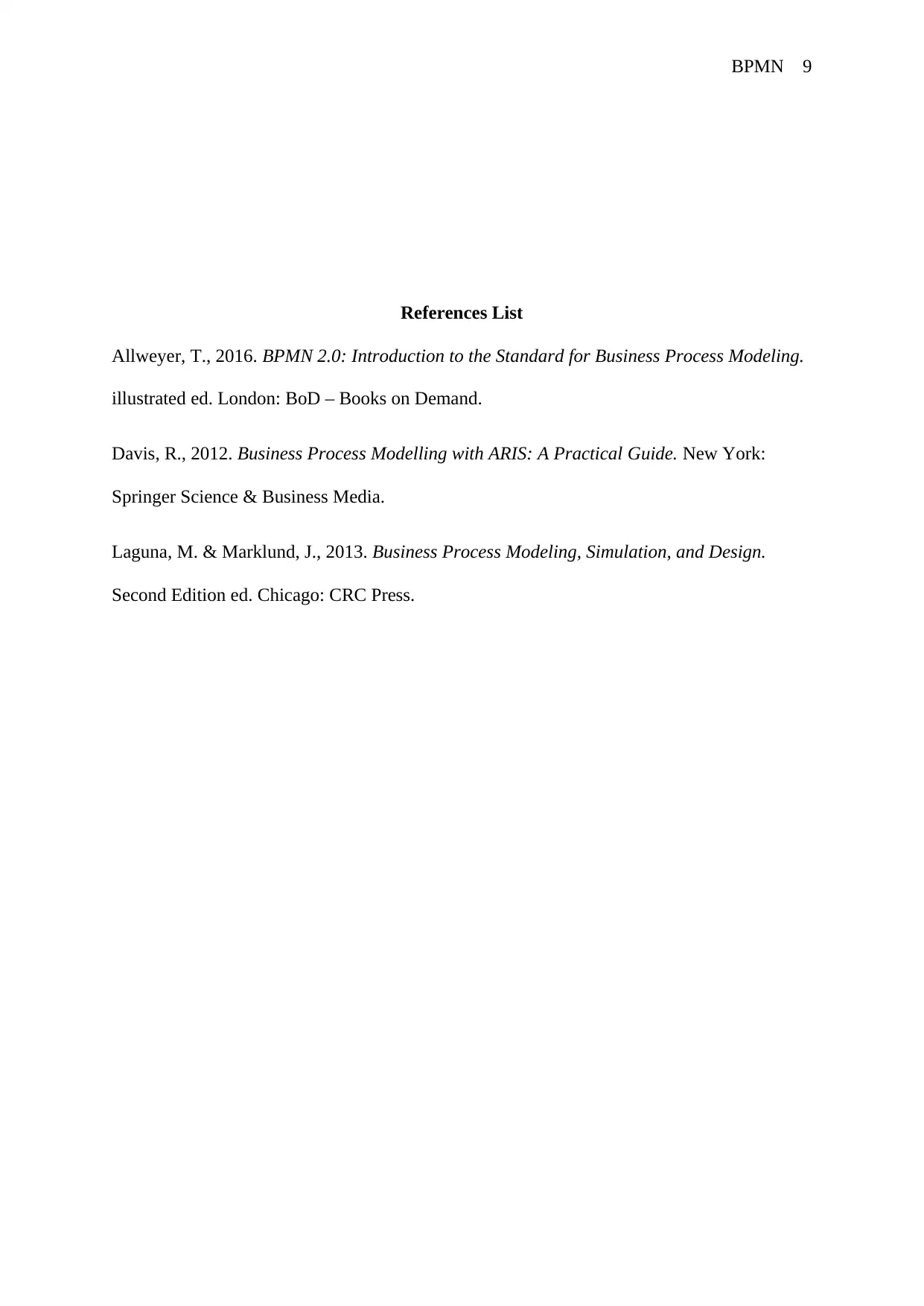
BPMN 9
References List
Allweyer, T., 2016. BPMN 2.0: Introduction to the Standard for Business Process Modeling.
illustrated ed. London: BoD – Books on Demand.
Davis, R., 2012. Business Process Modelling with ARIS: A Practical Guide. New York:
Springer Science & Business Media.
Laguna, M. & Marklund, J., 2013. Business Process Modeling, Simulation, and Design.
Second Edition ed. Chicago: CRC Press.
References List
Allweyer, T., 2016. BPMN 2.0: Introduction to the Standard for Business Process Modeling.
illustrated ed. London: BoD – Books on Demand.
Davis, R., 2012. Business Process Modelling with ARIS: A Practical Guide. New York:
Springer Science & Business Media.
Laguna, M. & Marklund, J., 2013. Business Process Modeling, Simulation, and Design.
Second Edition ed. Chicago: CRC Press.
⊘ This is a preview!⊘
Do you want full access?
Subscribe today to unlock all pages.

Trusted by 1+ million students worldwide
1 out of 9
Related Documents
Your All-in-One AI-Powered Toolkit for Academic Success.
+13062052269
info@desklib.com
Available 24*7 on WhatsApp / Email
![[object Object]](/_next/static/media/star-bottom.7253800d.svg)
Unlock your academic potential
Copyright © 2020–2025 A2Z Services. All Rights Reserved. Developed and managed by ZUCOL.




